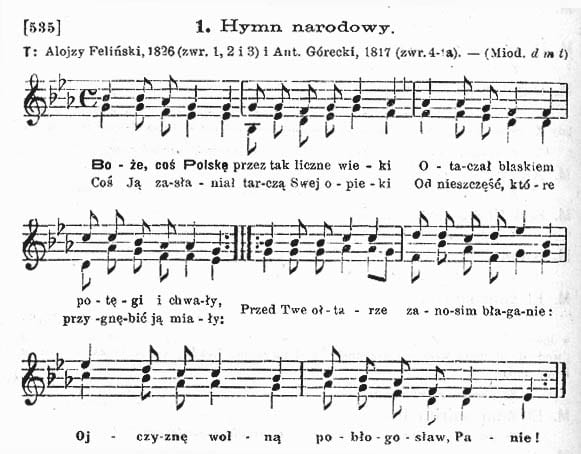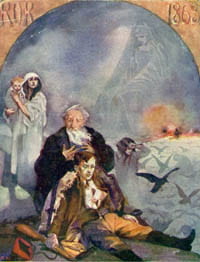Essay by Maja Trochimczyk
Boże, coś Polskę (God save Poland) is a solemn prayer for the nation, included in all Catholic Church songbooks, and sung in Polish churches. The hymn had a complicated history and in its creation at least three authors participated at different points in time. The original version dates back to 1816. Alojzy Feliński wrote the Hymn Commemorating the Proclamation of the Polish Kingdom Dedicated to the Polish Army by the Order of the Commander – in – Chief and Jan Nepomucen Kaszewski, asked by the Great Duke Konstanty, set the words to music. The National Song to King’s Good Fortune was the result of that co-operation. The text, which praised the Tsar, was written under the impact of the contemporary political developments (temporary liberial policy of Tsar Alexander I, following the Congress of Vienna). The hymn’s original refrain included the words “God bless the king” – referring to Tsar Alexander the First, who, after the defeat of Napoleon became the first ruler of the newly established Kingdom of Poland (1815).
However, this “servile” hymn was soon rejected by the Poles who suffered as a result of the policy of Russification introduced by the occupants. The hymn was rarely sung and rather unpopular. A new version emerged when a poet associated with the Polish Legion (the Polish troops fighting on the side of Napoleon), Antoni Gorecki , revised Feliński’s original to create The Hymn to the God for the Preservation of Liberty (1817). The pious refrain was changed to contain a prayer for God’s blessings not for the “king” but for “homeland.” That version spread among Poles at home and also among those who lived as emigrants abroad becoming a symbol of national resistance.
According to the research of Dioniza Wawrzykowska-Wierciochowa, the second melody of Boże, coś Polskę (ca. 1828), sometimes erroneously ascribed to Karol Kurpiński, or to a borrowing from a religious song, Beloved Mother, or to a quote from an aria by Jean Pierre Solie, was actually taken from a Cracow song, “Hail to you, Blessed Virgin Mary.” As this devotional melody was widely known and easier to sing, it altogether replaced the Kaszewski’s tune by the end of the year 1860.
Since its 1828 publication, the revised hymn, known as “The Prayer of the Polish Army,” gradually increased in popularity in Poland and abroad, especially in France – with its strongly pro-Polish popular sentiments.
In 1861 Charles de Montalembert translated the song into French. In the same year, the hymn was banned by the Tsarist government and its Polish representatives (it had served as an anthem of the January Insurrection, 1860-63). In order to subversively keep the favorite hymn in the communal memory, Poles used its melody for a different Church song (with new religious text), Beloved Mother.
It is interesting to compare the changeable parts of the refrain of God Save Poland as it envolved since the text’s inception. The first strophe, describing the past blessings that God bestowed on the country remains unchanged as “eternal” as its transcendental addressee. It is “our” needs and requests expressed in the final line of the refrain that are modified to reflect the changing political situations and priorities:
O, God who, through so many centuries,
surrounded Poland / with the brilliance of power and glory,
who has protected it / with the shield of your defense,
against the disasters that / were meant to defeat it.
Refrain:
To your altars we carry a prayer:
Save our King, Lord ! (1816)
Return our Homeland to us, Lord ! (1830)
Bless our Homeland and freedom, Lord ! (1989)
Bless our free Homeland, Lord ! (1996)
As it is clear from the refrains, the original prayer on behalf of the King was soon replaced by a request to regain independence, sought in a series of unsuccessful uprisings (1830, 1848, 1863) but realized only in 1918. God Save Poland became the national and religious anthem that was heard during the insurrections, wars and foreign occupations. The contemporary versions of God Save Poland (1989-96) ask for God’s blessings for free country, though there also exists another version popular in the 1980s (after the suppression of the Solidarity movement ): “Return our free homeland to us, Lord.” The Polish People’s Republic (1944-89) was officially an independent country, but the Solidarity supporters considered it an occupied zone of “Soviet influence” and prayed for its freedom. Until the present day God Save Poland has always been the most intense prayer for independence and peace.

Sources of Material
The text is based on Maja Trochimczyk’s essay “Sacred versus Secular: The Convoluted History of Polish Anthems,” in After Chopin: Essays in Polish Music, ed. Maja Trochimczyk, vol. 6 of Polish Music History Series (Los Angeles: Friends of Polish Music at USC, 2000).
The recording is from Boze, cos Polske CD, performed by State Folk Dance Group Mazowsze, issued by Polskie Nagrania, ECD 034.
The score included above is from Franciszek Baranski, ed. Jeszcze Polska nie zginela. Piesni patryotyczne i narodowe [Poland is not yet lost. Patriotic and National Songs] (Lwow: Ksiegarnia Polska Bernarda Polonieckiego, ca. 1910).
The 1928 edition is from Jan Siedlecki, ed. Spiewnik koscielny z melodjami na dwa glosy [Church Songbook with Melodies, for two Voices] (Lwow-Krakow-Paris: Missionary Fathers, 1928).
The 19th-century postcards of symbolic imagery and Polish emblems are from Maja Trochimczyk Collection.

